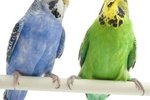
For some bird owners, conures are the perfect parrot. They're not too big, they're not too small. Conures are just right for most people. These birds belong to the long-tailed group of New World parrots, in the subfamily arinae. Some bird experts classify these birds along with parakeets, but the name "conure" has become acceptable for a large variety of bird species.
Conures as Companions
Conures make great pets because they are lively and inquisitive. They love attention and will perform for an audience. Conures are comfortable hanging upside-down or parading around while dancing. These antics win fans, because smiles just naturally occur during these performance sessions. Conures have bright feathers of many colors, and their long tails are magnificent. Their beaks are small, curved and mighty, able to crack seeds and nuts for nourishment. Like all parrots, conures have four toes on each foot, with pairs facing opposite directions to hold onto perches, food and other items.
Common Conures
Popular pet conures include the Nanday with its distinctive black head. Its wings and tail feathers are dark blue, and bright orange feathers appear on the legs and at vents. Other favorites include the green-cheeked conure and the maroon-bellied conure, which are quiet and cuddly. The largest of them is the magnificent Greater Patagonian conure. These birds are chatty and sociable, especially if hand raised. These are not the most colorful birds, but they make great pets because they love to be held and just to be with people.
More Favorites
The Aratinga conures, Latin for "little macaw," include the sun conure, jenday conure, dusky conures, peach front conures and others. These birds are active, and they can be loud. Blue-crowned conures -- aka blue-crowned parakeets -- are great talkers, but they require a lot of attention. As with most conures, owners should invest in an ample-sized cage and a variety of toys to keep these birds entertained and healthy. These are not birds for mere decoration, so owners should be willing to spend time and give attention to these avian wonders.
Wild Birds
Wild conure species exist in Central and South America, and they live in flocks of 20 or more. In some areas they are considered pests because they eat grain, and they will attack farm fields to satisfy their appetites. The bright tail feathers of some conures have had the attention of the millinery industries -- a threat to the birds, who otherwise have a lifespan of about 20 to 25 years. Recently, conure flocks have formed in non-native areas, from Hawaii to the western United States, to the Florida shores. Their noisy behaviors are considered entertaining or annoying -- depending on the eye of the observer.
References
Photo Credits
-
Jupiterimages/Photos.com/Getty Images
Writer Bio
Connie Jankowski began writing in 1987. She has published articles in "Dog Fancy" and "The Orange County Register," among others. Areas of expertise include education, health care and pets. She holds a Bachelor of Arts in communications from the University of Pittsburgh.



